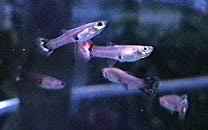Individual Fish Description Page


This page will give a completely detailed profile of the
selected fish, from A to Z. The profiled fish will be
chosen randomly by Badman, and will come from the complete
genre of tropical fish. I will try to up-date the profile
on a monthly basis. If you have a specific fish you want
profiled please vote for it in the favorite fish poll on
the main index page.


photo courtesy of sbs.
Female Guppies.
Poecillia reticulata
Classification
- Order: Atheriniformes.
- Sub-order: Cyprinodontoide.
- Family: Poecilidae.
- Genera: Poecillia
Common name
Guppy, Millions fish.
Distribution
South America, North of the Amazon and in Barbados aand Trinidad.
General Body Form
Males are elongated and the females are larger and plumper. In developed strains the male will show a large Caudal fin, usually brightly colored.
Coloration
Within its wide distribution range, this species has lots of natural varieties of color and form. These forms have been enhanced by selective breeding and hybridization, mainly to produce strains that are larger, more colorful and have larger fins.
Male guppies are the colorful sex in this species.. Even in the wild Guppies show quite a varied range of coloration and some of the species that inhabit the Islands are really interesting. The variability of colors produced by selective breeding is almost infinite. Typical features are large "eye" spots on the body and fins whose edges shine iridescently in all colors of the rainbow.
Females are usually a rather dull green to yellowish-Green. The scales have dark edges that give the body a reticutate appearance ( hense the name ). selective breeding has increased the females coloration, but as of yet they can't compare to the male.
Maintenance
An easily cared for fish that does well in all types of community aquaria. Give them a fairly large tank with live plants and open swimming areas, avoid too much drift-wood as a rule the livebearers do not like acidic water. Although not a schooling fish they benefit by being kept with a large number of their own kind. Temperature range from sixty-eight to eighty-seven degrees, water with a pH of 7 to 8.5 and hard to medium hard. You must provide a fairly large tank if you want their finage to develop to its potential. Cultivated varieties with very large fins should be kept singly. Guppies will except all types of flake food and small live food.
Biotope
Standing and slowly moving water, originally in Northern South America and the Caribbean.
Breeding
As the male matures the Anal fin develops into a structure for reproduction called the Gonopodium. The Gonopodium can be moved in almost any direction and stores the sperm in packs called spermatophores. Once the sperm is inserted into the female it fertilizers her eggs and the rest is stored in the Oviduct walls for later use. The eggs are very rich in yolk and the young develop by consumming their yolk stores. In light colored females pregnancy can be recognized by the growing dark body marking in front of the Anal fin. Selected varieties only produce their attractive features if they are given plenty of space and a varied diet. Very prolific, the females produce young every four weeks or so.
Young Live-bearers are fairly large at birth and their development is very advanced. They can swim right away, which is needed to avoid their enemies including their parents who give no natal care whatsoever. The fry grow very rapidly and will eagerly accept fine flake food.


Laurel Lake Guppy Hatchery
A
fabulous Website offering tons of great information about fancy guppies.
Fancy Guppy Home Page
French Guppy Page


back to the fish profile page.

Email:
badman2nd@hotmail.com






